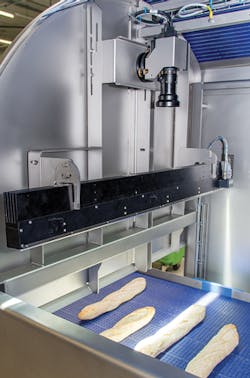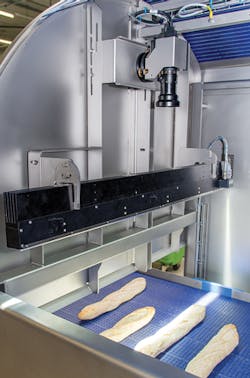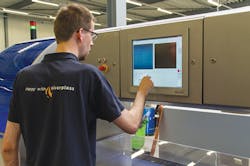Food inspection: Vision system inspects, counts bakery products
How do industrial bakeries ensure that only perfect bread gets delivered to their customers? Many rely on packaging and inspection equipment from Niverplast (Nijverdal, The Netherlands; www.niverplast.com). Recently, the in-house image processing specialist at Niverplast partnered with Stemmer Imaging (Puchheim, Germany; www.stemmerimaging.com) to advance the defect detection capabilities of its inspection equipment.
According to Albert Danneberg from the Niverplast R&D team, baked goods are conveyed from the freezer to the inspection equipment via an automated supply direct from the deep freezer, or by manual placement on the conveyor belt. First, a metal detector checks for undesired metal part contamination that can sometimes occur during the preceding processes.
Next, the baked goods enter the first machine vision installation that performs the quality check. The first requirement of the image processing system is to inspect the geometry of each item. So the image processing system has to measure the length, width and height of each baked good in order to detect any geometrical, dimensional or breakage errors. This image processing task is very challenging because no two loaves of bread are alike.
"The shapes of the pre-baked loaves of bread and bread rolls are never identical. They are always slightly different," says Dietmar Serbée, Stemmer Imaging managing director, Benelux branch. "It is very difficult for an automated system to decide, for example, whether a depression in the surface of a baguette is a deliberate cut or the start of an undesired breakage."
Also, the machine vision system should be able to be easily configured to determine whether features like browning, topping or roundness of the loaves or bread rolls meet quality requirements. Following an intensive development phase, Serbée was able to reliably distinguish between such features by developing a proprietary software solution within the Common Vision Blox image processing library.
Serbée also selected the necessary hardware components for the image processing system. "In the preliminary investigations we carried out tests to determine which camera, lens and illumination could achieve optimum results," Serbée explains. "In the end we chose a combination of line scan cameras and the matching line scan illumination and lenses." Depending on the width of the conveyor belt, one or two line scan cameras can be used to optimally cover widths up to 1300 mm.
Apart from the delivery of other components such as the PC systems and various cables, Stemmer Imaging also assisted in the imaging software integration with the graphical user interface (GUI) that operators use to select the next batch of bakery products to be inspected. "The GUI itself was made by Niverplast," Serbée remembers. "We cooperated closely on the connection in order to fully satisfy our customer's wishes."
The GUI allows for easy calibration. Users select the normal, minimum and maximum values of length, width, height, roundness, black spots and shape that would make up a passing quality grade. After the quality inspection station, the system automatically diverts faulty bakery items that fall outside of these parameters so that only good loaves proceed to the second station for counting and subsequent packaging.
To optimize counting accuracy at the counting station, operators use simple segmentation tools to train the vision system to understand how to visually separate items. Remote support capabilities built into the system enable fast correction of any problems that may arise. After counting, bakery items proceed to the packaging equipment where perfect bread in the desired quantity are packaged in cartons, bags or both.


